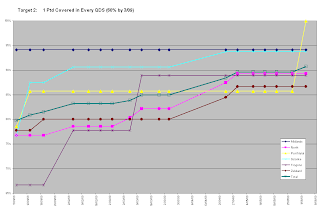This weekend saw me managing to atlas three pentads. Unfortunately no new ones, sorry Trish.
Saturday saw me off bright and early to Lynnfield Park (or Ashburton South) and along the Dardarnelles Road. Managed to clock up a not too bad list. Lowlight of this trip was a single Common Starling foraging with a flock of
Euplectes widowbirds. Then back home for breakfast and off to Durban.
While the rest of the family was off have various heads of hair done, I popped in at Umhlanga Lagoon NR, as I have not been there for some time. I see there is now a parking attendant at the car park, who wanted charged me R5 for the priviledge of parking there.
Anyway toddled off into the forest, with birding a little slow, as one can expect in a forest at 11h00. Sat for some time on the bridge across the stretching towards the main lagoon, watching a flock of Little bee-eaters hawking insects above the forest canopy and reedbeds. Then a very young Crowned Eagle made a brief appearance from the hotel end, only to pop into the forest canopy, just out of sight. Duly got to the end of the trail and thought I would nip along the beach and around the corner to see what waders were along the lagoon proper. Well, there may have been all sorts of birds, but I did not get that far as I hightailed it out of there: I was amazed to discover that KZN now has it's own version of Sandy Bay, and this at none other than Umhlanga Lagoon. I simply did not have the heart to stride through this lot with binoculars in hand looking for birds.
Back through the forest I got to watching a Yellow-rumped Tinkerbird. As is so often the case, this was the front-runner to a good bird-party, which included a Puffbacks, a Yellow-bellied Greenbul, a Golden-tailed Woodpecker, a Paradise Flycatcher, Yellow-breasted Apalis and then the highlight was a pair of Black-throated Wattle-eyes. This bird party was unfortunately broken up by a couple of prospective users of the lagoon beach, the male of which had already divested himself of most of his kit.
Back to the car park, to remonstrate with the attendant about not warning me about the goings-on on the beach, only to be blandly told that he thought that I knew about it. (Obviously not the only person in khaki shorts and shirt to come past).
Then drove around as much of the rest of the pentad as I could find, not adding too much other than a Stonechat, some doves and mynas.
On the way back I stopped along the Umgeni, hoping to complete another card. Pink-backed Pelican and the usual suspects along the Umgeni. Then into Burman Bush to see what was up. Really quiet forest birding as it was now 13h30. An African Goshawk provided some interest. Then a call from the family to pick them up and back home.
Got no birding done on Sunday [I have a mostly non-birding family], and Monday was work, which to misquote someone (GB Shaw, or was it the other bloke?), must surely be the curse of the birding classes.
Tuesday I had planned to atlas two new pentads, both on the edge of the Dalton sugar belt and going on down to the communal areas along the Umvoti River. At the door on my way out, my eldest asked if she could come along, 'Yes, of course'. Do not want to stifle any interest in birding [or atlassing], but definitely a change of route. I do not mind losing the trusty old Sentra as much as my daughter. So, instead we covered a pentad with 6 cards returned - if you cannot go where you wanted to , one might as well chase the Chamaeleon points.
In the end we had a really good morning's birding, despite a howling pre-frontal wind. Highlights were a trio of White-backed Ducks chasing each other around on the most unlikely looking location: a small dam right next to a really dusty District Road. This was soon followed by a Black Crake climbing a bugweed that was hanging over the pond.

 This is what we have achieved as at 8 October 2009 for SABAP2.
This is what we have achieved as at 8 October 2009 for SABAP2. Map of the cards per QDGC in SABAP2 less the cards per QDGC for SABAP1.
Map of the cards per QDGC in SABAP2 less the cards per QDGC for SABAP1. I then looked at the species richness per QDGC.
I then looked at the species richness per QDGC. This is the Species Richness map as at 8 October 2009 for SABAP2, reduced to QDGC's.
This is the Species Richness map as at 8 October 2009 for SABAP2, reduced to QDGC's. This map is of QDGC's where the SABAP1 species count per QDGC has been subtracted from that of SABAP2.
This map is of QDGC's where the SABAP1 species count per QDGC has been subtracted from that of SABAP2. To give one an idea of the finer spatial resolution that SABAP2 is using, this is what the species richness map for SABAP2 at the same date, looked like refined back to the project resolution of a pentad.
To give one an idea of the finer spatial resolution that SABAP2 is using, this is what the species richness map for SABAP2 at the same date, looked like refined back to the project resolution of a pentad.








